Do you want to learn how to play “Folsom Prison Blues” by Johnny Cash on guitar? At guitarplayers.net, we offer a comprehensive guide that simplifies the process of mastering this iconic tune, even if you’re just starting out. You’ll discover everything from basic chords to advanced strumming patterns. Unlock your musical potential and connect with a community of passionate guitar players. Ready to start your musical journey? Learn to play this classic song today!
1. What Makes “Folsom Prison Blues” a Great Song to Learn on Guitar?
“Folsom Prison Blues” is a fantastic choice for guitarists due to its simple chord progression, iconic status, and the opportunity to master essential guitar techniques. The song’s structure and recognizable melody make it an excellent addition to any guitarist’s repertoire. Learning to play it is a rewarding experience that enhances your musical skills and appreciation for classic country and blues music.
- Simple Chord Progression: The song primarily uses three chords (E, A, and B7), making it accessible for beginners. These chords are fundamental to many songs, providing a solid foundation for learning more complex pieces.
- Iconic Status: “Folsom Prison Blues” is one of Johnny Cash’s most recognizable songs, beloved by audiences worldwide. Playing it allows you to connect with a rich musical history and perform a song that people will instantly recognize and enjoy.
- Essential Guitar Techniques: Learning this song introduces you to essential techniques such as the boom-chick rhythm (associated with Luther Perkins) and palm-muting. These techniques are valuable for playing various styles of music, expanding your guitar-playing skills.
- 12-Bar Blues Structure: “Folsom Prison Blues” follows a 12-bar blues progression, a foundational structure in blues music. Mastering this progression helps you understand and play countless other blues songs.
- Blend of Country and Blues: The song uniquely blends country and blues elements, offering a versatile learning experience. This blend allows you to appreciate the nuances of both genres and incorporate them into your playing.
2. Who Wrote “Folsom Prison Blues” and What’s Its Story?
“Folsom Prison Blues” was written and originally recorded by Johnny Cash in 1955, becoming one of his signature songs. The song tells the story of a remorseful inmate longing for freedom, inspired by Cash’s performances in prisons and traditional folk tunes. In 1968, Cash recorded a live performance at Folsom State Prison, further solidifying the song’s significance.
- Johnny Cash’s Inspiration: Cash was inspired to write “Folsom Prison Blues” after seeing the film Inside the Walls of Folsom Prison. This sparked his interest in prison life, leading him to write a song that captured the emotions and experiences of inmates.
- Themes of Regret and Redemption: The lyrics reflect themes of regret, longing, and the desire for redemption. These themes resonated deeply with listeners, contributing to the song’s enduring popularity.
- Live Performance at Folsom Prison: The 1968 live performance at Folsom State Prison was a pivotal moment in Cash’s career. It captured the raw energy of his music and his connection with the inmates, enhancing the song’s authenticity.
- Cultural Impact: “Folsom Prison Blues” has had a lasting cultural impact, influencing numerous artists and remaining a staple in American music. Its themes and story continue to resonate with audiences today. According to research from the Country Music Hall of Fame and Museum, in June 2023, the song’s raw authenticity made it a hit.
- Connection to Traditional Folk Tunes: Cash drew inspiration from traditional folk tunes, such as “Crescent City Blues” by Gordon Jenkins, which influenced the melody and structure of “Folsom Prison Blues.”
3. What Are the Basic Chords Needed to Play “Folsom Prison Blues”?
To play “Folsom Prison Blues”, you’ll need three essential chords: E, A, and B7. These chords are fundamental in the key of E major and form the backbone of the song’s 12-bar blues progression. Mastering these chords will allow you to play the song and build a foundation for learning other songs in the same key.
-
E Chord: The E chord is played across all six strings and consists of the notes E, G#, and B. It serves as the tonic, or “home” chord, in the key of E, providing a sense of stability and resolution.
-
A Chord: The A chord is typically played from the 5th string down and includes the notes A, C#, and E. As the IV chord in the key of E, it introduces tension and anticipation, creating a classic blues progression when transitioning from E.
-
B7 Chord: The B7 chord is played from the 5th string down and contains the notes B, D#, F#, and A. As the V chord in the key of E, it creates a strong pull back to the tonic (E) chord, providing a satisfying resolution to the progression.
-
Chord Progression: The chords E, A, and B7 form the foundation for the song’s 12-bar blues progression, which is a standard structure in blues music. This progression is repeated throughout the song, providing its harmonic structure.
-
Key of E Major: These three chords (E, A, and B7) are essential for playing in the key of E major. They can be used in countless songs and progressions, making them valuable for any guitarist to learn.
4. What Is the 12-Bar Blues Progression in “Folsom Prison Blues”?
“Folsom Prison Blues” follows a 12-bar blues progression, a foundational structure in blues music. This progression uses the E, A, and B7 chords arranged in a specific sequence over 12 bars. Mastering this progression is essential for playing “Folsom Prison Blues” and understanding many other blues songs.
| Bar(s) | Chord |
|---|---|
| 1-4 | E |
| 5-6 | A |
| 7-8 | E |
| 9-10 | B7 |
| 11-12 | E |
- Structure Breakdown: The progression starts with four bars of E, followed by two bars of A, two bars of E, two bars of B7, and ends with two bars of E. This sequence creates a classic blues feel.
- Common Blues Structure: The 12-bar blues progression is used in countless blues songs, making it a fundamental element to learn. Understanding this structure opens the door to playing a wide variety of blues tunes.
- Playing in Whole Notes: To start, play each chord in whole notes, strumming once per bar and counting to four. This helps you internalize the progression before adding more complex rhythms.
- Versatility: Once you’re comfortable with the basic progression, you can experiment with different strumming patterns, variations, and embellishments to add your personal touch.
- Foundation for Improvisation: The 12-bar blues progression provides a solid foundation for improvisation. As you become more experienced, you can use scales and licks to create your solos within the structure of the progression.
5. How Do You Play the “Boom-Chick” Rhythm in “Folsom Prison Blues”?
The “boom-chick” rhythm is a distinctive feature of “Folsom Prison Blues,” popularized by Luther Perkins. This rhythm involves an alternating bass pattern combined with palm-muting to create a percussive sound. Mastering this technique adds authenticity to your playing and captures the song’s signature feel.
- Luther Perkins’ Style: Luther Perkins was known for his minimalist yet effective guitar playing style. His “boom-chick” rhythm provided the rhythmic backbone for many of Johnny Cash’s songs.
- Palm-Muting Technique: Palm-muting involves lightly resting the palm of your picking hand against the strings near the bridge of the guitar. This dampens the vibrations, creating a muted, percussive tone.
- Alternating Bass Pattern: The alternating bass pattern involves playing different bass notes on different beats. For the E chord, the pattern is typically 6-4-5-4 (string 6, string 4, string 5, string 4).
- Adapting to Different Chords: The bass pattern changes depending on the chord. For the A chord, the pattern is often 5-4-6-4. For the B7 chord, you can adjust the bass note on beats 2 and 4 by shifting your middle finger to the 6th string.
- Creating the Sound: Combine the palm-muting and alternating bass patterns to create the “boom-chick” rhythm. Practice slowly at first to ensure accuracy, then gradually increase the speed as you become more comfortable.
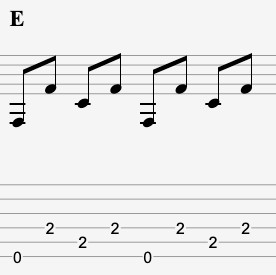 E strumming pattern
E strumming pattern
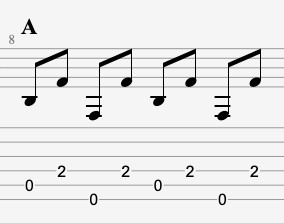 A strumming pattern
A strumming pattern
6. What Scales Can You Use to Solo in “Folsom Prison Blues”?
To solo effectively in “Folsom Prison Blues,” you can use the E major pentatonic scale and the E minor blues scale. These scales provide the notes and patterns needed to create bluesy and melodic solos that complement the song’s structure. Experimenting with these scales allows you to improvise and add your personal flair to the song.
- E Major Pentatonic Scale: The E major pentatonic scale consists of the notes E, F#, G#, B, and C#. This scale provides a bright and melodic sound that fits well with the major key tonality of the song.
- E Minor Blues Scale: The E minor blues scale consists of the notes E, G, A, Bb, B, and D. This scale includes a “blue note” (the Bb), which adds a bluesy and expressive quality to your solos.
- Scale Positions: You can play both scales in various positions on the guitar. A common position for both scales is at the 12th fret, which allows you to easily access the notes and patterns needed for soloing.
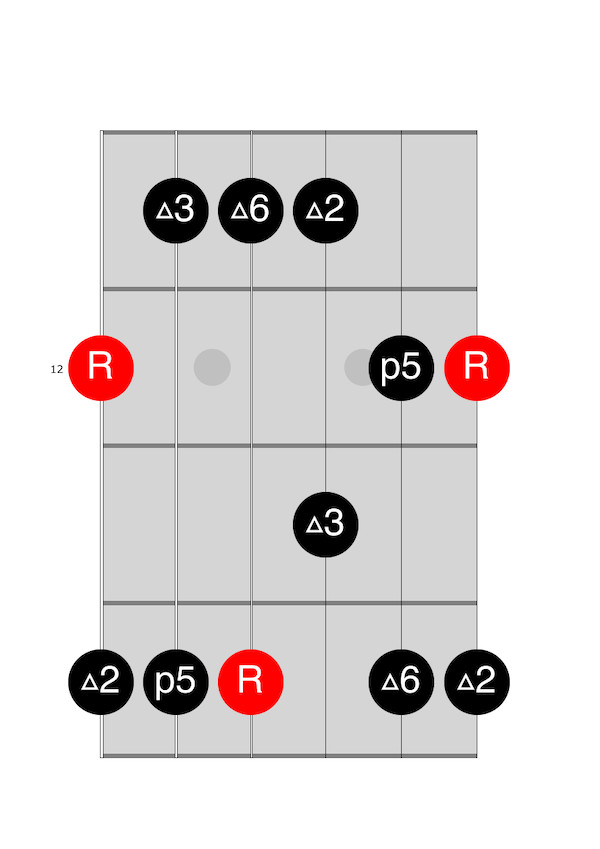 E major pentatonic 12th position
E major pentatonic 12th position
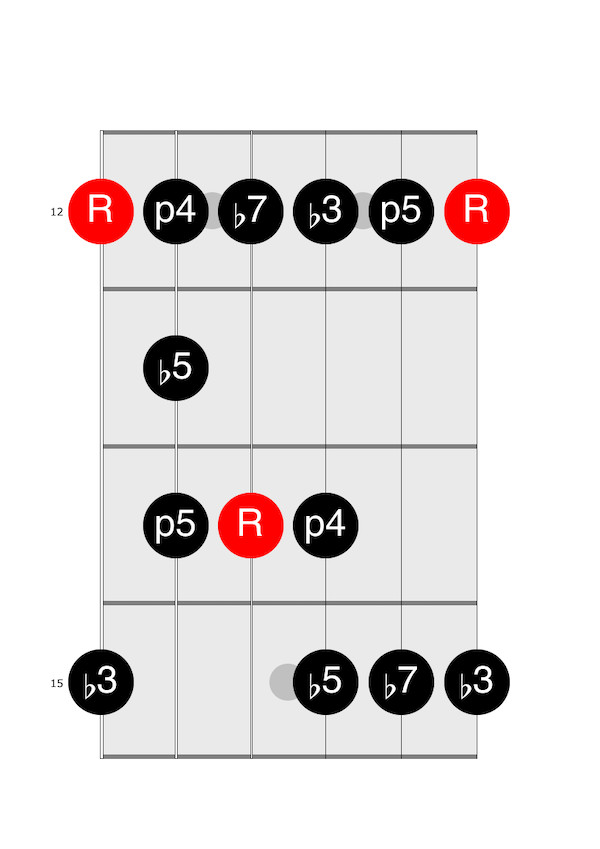 Em Blues Scale 12th position
Em Blues Scale 12th position
- Combining Scales: You can combine elements from both scales to create more dynamic and interesting solos. Experiment with blending major and minor pentatonic patterns to add depth and expression to your playing.
- Repetitive Figures: Using repetitive figures in your solos can create a sense of familiarity and catchiness. These figures can be short melodic motifs or longer patterns that are repeated with slight variations.
7. What Are Some Soloing Techniques to Enhance Your “Folsom Prison Blues” Performance?
Enhance your “Folsom Prison Blues” performance with techniques like bluesy strumming, incorporating fragments of the melody, and using repetitive figures. These methods add depth, rhythm, and familiarity to your solos, making your performance more engaging and authentic. Experiment with these techniques to develop your personal style and create memorable solos.
- Bluesy Strumming: Incorporating strumming patterns into your solos adds a rhythmic and textural element that can be very effective. Instead of relying solely on single-note melodies, use your pick or fingers to strum the strings in a bluesy manner.
- Fragments of the Melody: Incorporating fragments of the song’s melody into your guitar solo establishes a strong connection between the solo and the song itself. This can be engaging and comforting for the audience, as they identify with the familiar tune.
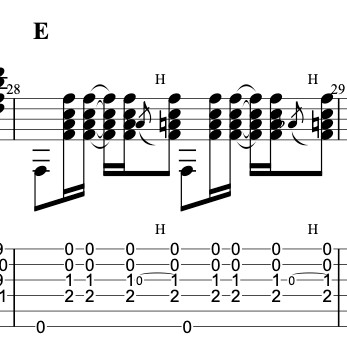 Folsom Prison Blues Lick 2
Folsom Prison Blues Lick 2
- Repetitive Figures: Using repetitive figures in your guitar solos can add a sense of familiarity, catchiness, or emphasis. This repetition can be a deliberate artistic choice, making the solo more memorable.
- Call and Response: Implement a call-and-response approach in your solos, where you play a phrase and then respond to it with another phrase. This creates a musical conversation and adds interest to your solo.
- Dynamics and Expression: Vary the dynamics and expression in your solos by using techniques like bending notes, vibrato, and slides. These techniques add emotion and character to your playing.
8. What Gear Did Johnny Cash and Luther Perkins Use for “Folsom Prison Blues”?
Johnny Cash and Luther Perkins used specific guitars and gear that contributed to the signature sound of “Folsom Prison Blues.” Cash primarily used his Martin D-28 acoustic guitar, while Perkins favored his Fender Esquire. Understanding their equipment can help you emulate their sound and appreciate their unique contributions to the song.
- Johnny Cash’s Guitar: Johnny Cash was known for playing a Martin D-28 acoustic guitar. This guitar provided a rich and full sound that complemented his deep voice.
- Luther Perkins’ Guitar: Luther Perkins famously played a Fender Esquire, a single-pickup electric guitar. This guitar produced a bright and twangy tone that was perfect for his minimalist style. According to Guitar Player Magazine in their June 2024 edition, his Esquire was key to his signature sound.
- Amplifiers: Luther Perkins often used a Fender Tweed Deluxe amplifier. This amp provided a warm and slightly overdriven sound that enhanced his guitar’s tone.
- Strings and Picks: The specific strings and picks used by Cash and Perkins are not widely documented, but it is likely that they used medium-gauge strings and standard picks to achieve their respective sounds.
- Modern Alternatives: While vintage gear can be expensive, modern alternatives can help you achieve a similar sound. Fender and Martin offer guitars that replicate the models used by Perkins and Cash, and many amp manufacturers produce amps that emulate the sound of the Fender Tweed Deluxe.
9. Are There Any Common Mistakes to Avoid When Playing “Folsom Prison Blues”?
When learning “Folsom Prison Blues,” avoid common mistakes such as rushing the tempo, neglecting palm-muting, and incorrect chord transitions. These errors can detract from the song’s authentic feel and make it harder to play accurately. By focusing on precision and mastering the key techniques, you can achieve a more polished and satisfying performance.
- Rushing the Tempo: Maintaining a steady tempo is crucial for capturing the song’s relaxed feel. Avoid rushing the tempo, especially when transitioning between chords.
- Neglecting Palm-Muting: Palm-muting is essential for creating the percussive “boom-chick” rhythm. Neglecting this technique will result in a less authentic sound.
- Incorrect Chord Transitions: Smooth and accurate chord transitions are important for maintaining the flow of the song. Practice transitioning between E, A, and B7 chords until you can do so seamlessly.
- Ignoring Dynamics: Varying the dynamics of your playing can add depth and expression to your performance. Avoid playing everything at the same volume and experiment with softer and louder passages.
- Overcomplicating the Solo: The solo in “Folsom Prison Blues” should be simple and melodic. Avoid overcomplicating it with excessive notes or flashy techniques.
10. How Can Guitarplayers.net Help You Learn “Folsom Prison Blues” and More?
Guitarplayers.net provides a wealth of resources to help you learn “Folsom Prison Blues” and enhance your guitar playing skills. With lessons, reviews, sheet music, and a supportive community, you’ll find everything you need to master this iconic song and continue your musical journey. Join our community today and start playing your favorite tunes!
- Comprehensive Lessons: Access step-by-step lessons that break down “Folsom Prison Blues” into manageable sections. These lessons cover everything from basic chords to advanced techniques, ensuring you have a solid understanding of the song.
- Guitar and Gear Reviews: Get unbiased reviews of guitars, amps, and accessories to help you make informed decisions about your gear. Our reviews cover a wide range of products, from beginner-friendly options to professional-grade equipment.
- Extensive Sheet Music Library: Find sheet music and tabs for “Folsom Prison Blues” and thousands of other songs. Our library includes a variety of genres and skill levels, so you can always find something new to learn.
- Community Forum: Connect with a community of passionate guitar players who are eager to share their knowledge and experiences. Ask questions, get feedback, and collaborate with others to improve your playing.
- Expert Tips and Advice: Benefit from expert tips and advice from experienced guitarists and instructors. Our articles and tutorials cover a wide range of topics, from technique and theory to gear and maintenance.
Ready to dive in? Visit guitarplayers.net today and discover the resources you need to master “Folsom Prison Blues” and take your guitar playing to the next level. Explore our lessons, find your favorite sheet music, read insightful reviews, and join our vibrant community. Let’s make some music together! For inquiries, contact us at:
Address: 1140 Boylston Street, Boston, MA 02215, United States
Phone: +1 (617) 747-2261
Website: guitarplayers.net
FAQ: Mastering “Folsom Prison Blues” on Guitar
- Is “Folsom Prison Blues” hard to play on guitar?
“Folsom Prison Blues” is relatively easy to play for beginners as it involves only three basic chords: E, A, and B7. However, mastering the “boom-chick” rhythm can be more challenging and requires practice. - What chords are used in “Folsom Prison Blues”?
The main chords used in “Folsom Prison Blues” are E, A, and B7. These chords form the foundation of the song’s 12-bar blues progression. - How do you play the “boom-chick” rhythm on guitar?
To play the “boom-chick” rhythm, use palm-muting and an alternating bass pattern. For the E chord, the pattern is typically 6-4-5-4 (string 6, string 4, string 5, string 4). Adapt the pattern for the A and B7 chords. - What is the 12-bar blues progression?
The 12-bar blues progression is a standard structure in blues music. In “Folsom Prison Blues,” it consists of four bars of E, two bars of A, two bars of E, two bars of B7, and two bars of E. - Can you use a capo to play “Folsom Prison Blues”?
Yes, you can use a capo on the 1st fret to play in the key of E, making the chords easier to manage. Without a capo, you would play in the key of F. - What scales can you use for soloing in “Folsom Prison Blues”?
You can use the E major pentatonic scale and the E minor blues scale for soloing in “Folsom Prison Blues.” These scales provide the notes needed to create bluesy and melodic solos. - What guitar did Luther Perkins use to play “Folsom Prison Blues”?
Luther Perkins famously used a Fender Esquire, a single-pickup electric guitar, to play “Folsom Prison Blues.” This guitar produced his signature twangy tone. - How can I improve my chord transitions when playing “Folsom Prison Blues”?
Practice smooth and accurate chord transitions by focusing on finger placement and timing. Start slowly and gradually increase the speed as you become more comfortable. - What are some common mistakes to avoid when playing “Folsom Prison Blues”?
Avoid rushing the tempo, neglecting palm-muting, incorrect chord transitions, and overcomplicating the solo. Focus on precision and mastering the key techniques to improve your performance. - Where can I find guitar lessons and sheet music for “Folsom Prison Blues”?
You can find guitar lessons, sheet music, and a supportive community at guitarplayers.net. We offer a wealth of resources to help you learn “Folsom Prison Blues” and enhance your guitar playing skills.
